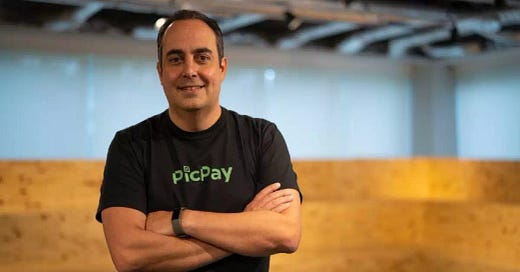This article is part of Fintech Leaders, a newsletter with 75,000+ builders, entrepreneurs, investors, regulators, and students of financial services. I invite you to share and sign up. If you enjoy this conversation, please consider leaving a review on Apple, Spotify, or Youtube.
In this episode, I travel to Sao Paulo for an interview with Eduardo Chedid, CEO of PicPay, a Brazilian fintech giant that has quietly become one of the most important financial companies in Latin America.
With 60 million customers and handling 11% of all Pix payments transactions in Brazil, PicPay has achieved profitability while maintaining hyper-growth—posting 61% revenue growth and 7× higher profits in 2024.
In this episode, we discuss:
How PicPay transformed from a digital wallet into a multi-product financial platform
"People say, Well, this is a tech business, this is a financial business. And I say, this is a people business! Because, you can have the best tech, but if we don't have the best team, that makes a huge difference."
PicPay was founded in 2012 as a simple QR Code payment app—essentially "Pix before Pix existed" in Eduardo's words or you can think of it as a Venmo/Cash App for Brazil. For its initial eight years, the company operated primarily as a digital wallet provider, but when Brazil's central bank launched the Pix instant payment system in 2020, many predicted PicPay's demise. Instead, the company saw an opportunity to expand and leveraged its payment expertise to capture a disproportionate share of Pix transactions while simultaneously expanding its product suite to become a full banking institution.
The real inflection point came in late 2022 when they shifted from an asset-light, fee-based distribution model to lending and credit products on PicPay's balance sheet. If the company was gonna succeed in the long term, Eduardo understood that it was crucial to start controlling the full customer experience, especially for relationship products like credit cards. This bold step has transformed PicPay's revenue mix. Credit products now represent ~40% of revenue, up from single digits just a few years ago and despite taking on balance sheet risk, the company has maintained an impressive 19% ROE.
The power of business unit autonomy and prioritizing top talent acquisition
“We are fully organized with business units. And I know that business units is not a new concept, but we take it to the limit. So, if you ask me, who is your CTO, I will answer, we have 16 because you have one CTO for each of those business units.”
PicPay's organizational structure sets it apart from other financial institutions and even most tech companies. Eduardo has implemented a radical business unit model that gives managers autonomy "to the limit." Each of their 16 business units operates with its own CTO, CPO, and HR leadership, functioning essentially as startups within the larger organization. According to Eduardo, this approach gives clear ownership to leaders and eliminates the classic corporate excuse of "I didn't deliver because I didn't get prioritized." Once capital is allocated to each unit annually, they have complete responsibility for execution, leading to product velocity that has enabled PicPay to launch at least one new product monthly since 2021.
This is not a simple and easy structure, and it requires disciplined coordination from senior leadership to ensure a unified customer experience across touchpoints. It adds additional management complexity, but Eduardo argues it’s worth the trade-off in speed and accountability.
Building a two-sided ecosystem that serves both consumers and businesses with separate monetization strategies
While most businesses choose to focus on either consumer or business, PicPay serves both sides of the market through an ecosystem approach. Their consumer business has reached massive scale with 60 million customers (40 million active). Meanwhile, the merchant side continues to grow rapidly, with the company's payment solutions increasingly adopted by businesses across Brazil.
What makes PicPay's approach unique is their balancing business unit that sits between these two segments. This unit has dual mandates: monetize non-financial interactions (like gaming credits, mobile top-ups, and in-app advertising) while driving ecosystem engagement. Unlike purely profit-focused units, this team optimizes for engagement metrics, often passing back monetization opportunities directly to customers through cashback on purchases. This flywheel effect keeps both sides of the marketplace growing, accelerates user engagement and creates a self-reinforcing growth cycle. Interestingly, when I asked him if PicPay is or is becoming a Super-App, Eduardo rejects this label, preferring to describe PicPay as a financial platform with expanded capabilities.
Why Brazilian market volatility creates resilient managers and how to avoid the "incumbent trap"... and a lot more!
"You had several banks, global banks, coming to Brazil and basically saying, now we're gonna show you how things are really done. And 15 years later, the only one that actually remains [in Brazil] is Santander, and basically because they actually acquired a very large Brazilian bank."
Eduardo's perspective has been shaped by experiences on both sides of the corporate landscape—as a leader at incumbents like Visa, Cielo, and Elo and now as disruptor CEO of PicPay. This dual vantage point gives him clarity on the "incumbent trap" that has sunk numerous Brazilian and international financial giants.
The dilemma is simple: established players become paralyzed trying to balance short-term results against long-term innovation, especially when innovation might cannibalize existing revenue streams. Eduardo witnessed this firsthand at Cielo, where he saw new entrants challenging with different pricing and flexibility while the incumbent struggled to respond fast. This crystallized his belief in what becomes the paradoxical "challenger advantage"—it's harder to compete against established players, but easier to avoid strategic mistakes.
Brazil's unique financial landscape amplifies these dynamics. The market has cycled from fragmentation to extreme consolidation (with just 6-7 major banks dominating) and now back toward increased competition through fintech innovation. Major credit goes to the Brazilian Central Bank for fostering this competitive environment through initiatives like Pix and open finance. The country's economic volatility also creates resilient business leaders.
"If you get people that have been through Brazil for a while, they're going to be top managers, because they're used to all this volatility,"
This adaptability explains why international financial institutions have historically struggled in Brazil despite repeated attempts.
Want more podcast episodes? Join me and follow Fintech Leaders today on Apple, Spotify, or your favorite podcast app for weekly conversations with today’s global leaders that will dominate the 21st century in fintech, business, and beyond.
Previous Episodes You May Enjoy:


























Share this post